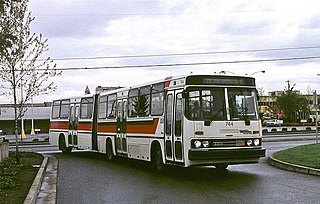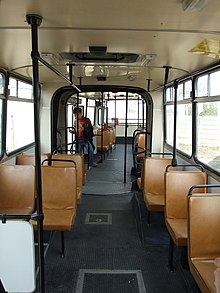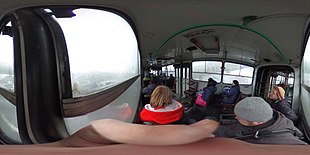
An articulated bus, also referred to as a slinky bus, bendy bus, tandem bus, vestibule bus, stretch bus, or an accordion bus, is an articulated vehicle, typically a motor bus or trolleybus, used in public transportation. It is usually a single-decker, and comprises two or more rigid sections linked by a pivoting joint (articulation) enclosed by protective bellows inside and outside and a cover plate on the floor. This allows a longer legal length than rigid-bodied buses, and hence a higher passenger capacity (94–120), while still allowing the bus to maneuver adequately.

Budapesti Közlekedési Zrt. or BKV Zrt. is the main public transport operator in Budapest, Hungary. BKV was established in 1968 as a unified public transport company with the merger of the companies responsible for the different means of transport; bus operator FAÜ, tram and trolleybus operator FVV, suburban railway operator BHÉV and riverboat operator FHV. The metro was added in 1973. The transport in Budapest underwent another reorganization in 2010 when the BKK was founded for the management of the city transport and infrastructure.

The Mercedes-Benz O305 was a single deck and articulated bus manufactured by Mercedes-Benz in Mannheim, West Germany from 1969 until 1988. It was built as either a complete bus or a bus chassis and was the Mercedes-Benz adaptation of the unified German VöV-Standard-Bus design, that was produced by some different bus manufacturers including Büssing, Magirus-Deutz, MAN, Ikarus, Gräf/Steyr, Heuliez, Renault, and Pegaso. The O305 was designed for use as a single-decker bus, however it was later redesigned to accommodate double-decker bodies.

The Mercedes-Benz Citaro is a single-decker, rigid or articulated bus manufactured by Mercedes-Benz/EvoBus. Introduced in 1997, the Citaro is available in a range of configurations, and is in widespread use throughout Europe and parts of Asia, with more than 55,000 produced by December 2019.

Ikarus was a bus manufacturer based in Budapest and Székesfehérvár, Hungary. It was established in 1895 as Imre Uhry's Blacksmith Workshop and Coach Factory(hun.: Uhry Imre Kovács- és Kocsigyártó Üzeme) and during the Communist era in Hungary it dominated bus markets of the entire Eastern Bloc and its allies.

A bi-articulated bus or double-articulated bus and sometimes train-bus, tram-bus, trackless tram or double bendy bus is a type of high-capacity articulated bus with an extra axle and a second articulation joint, as well as extended length. Bi-articulated buses tend to be employed in high-frequency core routes or bus rapid transit schemes rather than in conventional bus routes.
Ikarbus a.d. was a Serbian bus manufacturer based in Zemun, Belgrade.

Rocar DAC was a series of buses and trolleybuses produced by the Autobuzul company of Bucharest, Romania, between 1979 and 2000. They were available in both standard 12-meter models and articulated, 17-meter models. The first examples to enter service were DAC 117UDs that were made towards the end of 1978 and entered service with the ITB in Bucharest in April 1979.

The Bedford CA was a distinctive pug-nosed light commercial vehicle produced between 1952 and 1969 by Bedford in Luton, England.
Rocar was a van, light truck, bus and trolleybus manufacturer based in Bucharest, Romania. The firm also produced light offroad vehicles and later heavy road vehicles. During its existence, the company produced over 350,000 vehicles.

Karosa B 741 is an articulated urban bus produced from 1991 to 1997 by bus manufacturer Karosa from the Czech Republic. In many towns they replaced Ikarus 280 made in Hungary. It was succeeded by Karosa B 941 in 1997.

The RÁBA Automotive Group, commonly known as Rába, is a Hungarian public limited company, listed on the Budapest Stock Exchange. Rába engineers, manufactures and customizes automotive components, specialty vehicles and axles for commercial vehicles, agri-machinery and earth-movers. The Rába has been building axles as well as complete vehicles since 1902. The company has three strategic business units. The company is headquartered in Győr, employing more than 2000 people.

The Crown-Ikarus 286 is a type of transit bus that was manufactured for the U.S. market from 1980 until 1986, under a joint venture between the Ikarus Body and Coach Works (Ikarus), of Budapest, Hungary, and Crown Coach Corporation from Los Angeles, California in the United States. Loosely based on the Ikarus 280, the Crown-Ikarus 286 is a high-floor articulated bus.

Karosa B 941 is an articulated urban bus produced from 1997 to 2002 by bus manufacturer Karosa from the Czech Republic. An upgraded version, Karosa B941E, was introduced in 1999. In many towns they replaced Ikarus 280 made in Hungary. In production was succeeded by Karosa B 961 in 2002.

Jelcz M11 is a Polish step-entrance city bus manufactured by Jelczańskie Zakłady Samochodowe in Jelcz-Laskowice near Oława. It was manufactured from 1985 until 1990. It was a hybrid, made from the modified body chassis of Jelcz PR110 and frame and drivetrain of Ikarus 260.

The Ikarus 250 is a high-floor bus used as a coach for long-distance service. It was made from 1968–1989, alongside the smaller Ikarus 256, by the Hungarian bus manufacturer Ikarus.

The Ikarus 256 is a high-floor bus used as a coach for long-distance service and for interurban traffic. It was made from 1977–1989, alongside the larger Ikarus 250, by the Hungarian bus manufacturer Ikarus.

The Ikarus 55 is a high-floor coach designated for long-distance as well as interurban traffic, and the first rear-engine Ikarus bus. It was made from 1952 – 1973, alongside the technically related Ikarus 66, by the Hungarian bus maker Ikarus. In total, 8,350 Ikarus 55 and 66 were delivered to East-Germany.

The MAZ-215 is a Belarusian low-floor articulated bus from the Minsk Automobile Plant. The vehicle is an articulated bus with a driven central axle and corresponding to a drive formula of 6 × 2 (2). It is the successor of the MAZ-205.

The Ikarus 260 is a high-floor, three-door bus for city and suburban transportation purposes. It was made from 1971 to 2002 by the Hungarian bus manufacturer Ikarus, making it the longest manufactured, largest quantity model of the factory.




















